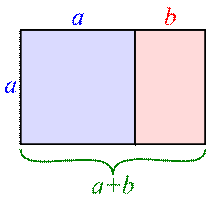Golden ratio
The golden section is a line segment divided
according to the golden ratio: The total length a + b is to the length of the longer segment a as the length of a is to the length of the shorter
segment b.
In mathematics and the arts, two quantities are in the golden ratio if the ratio of the sum of the quantities to
the larger quantity is equal to the ratio of the larger
quantity to the smaller one. The golden ratio is an irrational mathematical constant, approximately
1.61803398874989.[1] Other names frequently used for the golden ratio
are the golden
section (Latin: sectio aurea) and golden mean.[2][3][4] Other terms encountered include extreme and mean ratio,[5] medial section, divine
proportion, divine section(Latin: sectio divina), golden proportion, golden cut,[6] golden number, and mean of Phidias.[7][8][9] In this article the golden ratio is denoted by
the Greek lowercase
letter phi (![]() ),
while its reciprocal,
),
while its reciprocal, ![]() or
or ![]() , is denoted by the uppercase
variant Phi (
, is denoted by the uppercase
variant Phi (![]() ).
).
The figure on the right illustrates the geometric
relationship that defines this constant. Expressed algebraically:
![]()
This equation has one positive solution in the set of algebraic irrational numbers:
At least since the Renaissance, many artists and architects have proportioned their works to approximate the
golden ratio—especially in the form of the golden rectangle, in which the ratio of the longer side to the
shorter is the golden ratio—believing this proportion to be aesthetically pleasing (see Applications and
observations below). Mathematicians have studied the golden ratio because of its
unique and interesting properties. The golden ratio is also used in the
analysis of financial markets, in strategies such as Fibonacci retracement.
Construction
of a golden rectangle:
1. Construct a unit square (red).
2. Draw a line from the midpoint of one side to an opposite corner.
3. Use that line as the radius to draw an arc that defines the long dimension
of the rectangle.
A golden rectangle with longer side aand shorter side b, when placed adjacent to a
square with sides of length a, will produce a similar golden rectangle with longer
side a + b and shorter side a. This illustrates the
relationship ![]()
Calculation
|
List of numbers – Irrational and
suspected irrational numbers |
|
|
1.1001111000110111011… |
|
|
1.6180339887498948482… |
|
|
1.9E3779B97F4A7C15F39… |
|
|
|
|
|
|
|
|
|
|
Two quantities a and b are said to be in the golden ratio φ if:
![]()
One method to find the value of φ is to start with the
left fraction. Through simplifying the fraction and substituting in b/a =
1/φ,
![]() ,
,
it is shown that,
![]()
Multiplying by φ gives
![]()
which can be rearranged to
![]()
Using the quadratic formula gives the only positive solution as,
![]()




